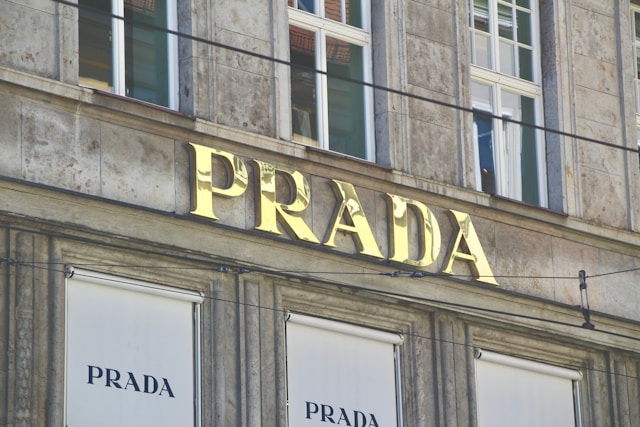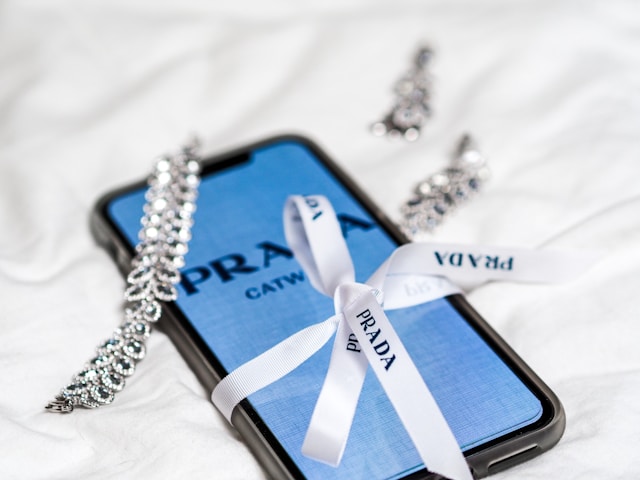Prada, one of the most prestigious names in the fashion industry, has consistently demonstrated its prowess in maintaining a strong brand identity while evolving with the times. For marketing professionals seeking inspiration, Prada offers a masterclass in how to blend tradition with innovation, craft with commerce, and exclusivity with accessibility.
The Prada Brand: A Brief Overview
Founded in 1913 by Mario Prada, the Italian luxury fashion house began as a leather goods shop in Milan. Over the decades, it has grown into a global powerhouse, known for its high-quality products, innovative designs, and cutting-edge fashion. The brand’s journey from a small shop to a leading name in luxury fashion underscores its effective marketing strategies, which seamlessly integrate heritage, exclusivity, and modernity.

Core Elements of Prada’s Marketing Strategy
Heritage and Craftsmanship
Prada’s marketing strategy is deeply rooted in its rich heritage and commitment to craftsmanship. The brand consistently emphasizes its history and the artisanal quality of its products, which resonates with a clientele that values tradition and authenticity. This focus on heritage is evident in their marketing materials, store designs, and product lines that often pay homage to classic styles and techniques.
For instance, Prada’s campaigns frequently highlight the meticulous process behind their products. Videos and social media content showcasing artisans at work, crafting bags or stitching garments, reinforce the message of quality and heritage. This approach not only differentiates Prada from fast fashion brands but also builds a narrative of timeless luxury.
Innovation and Modernity
While Prada is deeply connected to its past, it is equally committed to innovation. The brand’s ability to stay ahead of fashion trends and incorporate contemporary elements into its designs is a significant aspect of its marketing strategy. Prada often collaborates with artists, architects, and designers to create avant-garde collections and unique retail environments.
A notable example is the “Prada Invites” project, where the brand collaborates with prominent architects and designers to create special collections. This initiative not only generates buzz but also positions Prada as a forward-thinking brand that embraces creativity and innovation.
Exclusivity and Accessibility
Prada masters the balance between exclusivity and accessibility. While maintaining a luxurious aura, the brand also ensures that it is within reach for a broader audience through strategic product lines and marketing campaigns. The introduction of more affordable product lines, such as Prada Linea Rossa (Red Line), helps attract younger and more diverse customers without diluting the brand’s luxury status.
Marketing campaigns for these lines often feature younger, trendier models and are promoted heavily on social media platforms like Instagram and TikTok. This strategy helps Prada stay relevant and desirable among younger generations while preserving its exclusive image.

Digital Transformation and E-Commerce
Prada has embraced digital transformation, ensuring a strong online presence through e-commerce, social media, and digital marketing. The brand’s website offers a seamless shopping experience, combining sophisticated design with user-friendly navigation. Prada also utilizes digital storytelling to engage with customers, sharing behind-the-scenes content, fashion shows, and interactive experiences.
The brand’s digital campaigns often include immersive elements, such as virtual reality fashion shows and augmented reality try-ons. These initiatives not only enhance the customer experience but also position Prada as a tech-savvy, modern brand.
Successful Prada Marketing Campaigns
The Iconoclasts (2009)
One of Prada’s most memorable campaigns, “The Iconoclasts,” involved collaboration with four influential fashion editors: Carine Roitfeld, Olivier Rizzo, Alex White, and Katie Grand. Each editor was given carte blanche to redesign a Prada store’s interior, transforming it into their unique vision. The campaign generated significant buzz, as it blended fashion, art, and retail in an unprecedented way. It showcased Prada’s willingness to break norms and collaborate with creative visionaries, reinforcing its image as an innovative and avant-garde brand.
Prada 365 (2017)
Launched in 2017, the Prada 365 campaign marked a shift in the brand’s advertising approach. Instead of traditional seasonal campaigns, Prada 365 introduced a continuous, evolving narrative throughout the year. This campaign used multiple perspectives and storytelling techniques, featuring a diverse cast of models and photographers.
Prada 365 leveraged social media platforms extensively, releasing a steady stream of content that kept the audience engaged. This strategy not only enhanced brand visibility but also allowed Prada to tell richer, more varied stories that resonated with different segments of its audience.
Prada Re-Nylon (2019)
In response to growing environmental concerns, Prada launched the Re-Nylon initiative in 2019, a groundbreaking move to produce sustainable fashion. The campaign aimed to convert all of Prada’s nylon products to a sustainable material made from recycled ocean plastics and textile waste by 2021.
The Re-Nylon campaign was promoted through various channels, including a documentary series in partnership with National Geographic. The series highlighted the journey of the recycled materials from collection to finished product, reinforcing Prada’s commitment to sustainability and transparency. This initiative not only positioned Prada as a leader in sustainable fashion but also appealed to environmentally conscious consumers.
Leveraging Social Media and Influencer Marketing
Prada’s social media strategy is a blend of high fashion aesthetics and engaging content. The brand’s Instagram account, for instance, serves as a visual diary that showcases its latest collections, behind-the-scenes moments, and collaborations. Prada’s social media presence is carefully curated to maintain its luxurious image while also being interactive and engaging.
Influencer marketing is another key component of Prada’s digital strategy. The brand collaborates with a diverse range of influencers, from established fashion icons to emerging social media stars. These collaborations help Prada reach different demographics and amplify its message across various platforms. For example, Prada’s partnerships with influencers like Chiara Ferragni and A$AP Rocky have brought the brand closer to younger audiences, making it more relatable and aspirational.
In-Store Experience and Global Presence
Prada’s retail strategy is a critical part of its overall marketing approach. The brand’s stores are not just places to shop but are designed as immersive experiences that reflect Prada’s identity. From the architectural designs by Rem Koolhaas to the art installations and exclusive in-store events, every element is carefully crafted to create a memorable experience for customers.
The flagship stores, particularly the ones in Milan, Tokyo, and New York, are iconic and often serve as cultural landmarks. These stores host exclusive events, art exhibitions, and private viewings, further enhancing the brand’s prestige and allure.
Strategic Partnerships and Collaborations
Prada’s strategic partnerships and collaborations extend beyond the fashion world, encompassing art, architecture, and even technology. These collaborations not only generate excitement but also reinforce Prada’s image as a brand that transcends fashion.
One such collaboration was with renowned filmmaker Wes Anderson for the short film “Castello Cavalcanti” in 2013. This project was part of Prada’s “Prada Classics” series, which merges fashion with other forms of art and culture. By associating with a filmmaker known for his distinct aesthetic, Prada reinforced its own unique style and storytelling prowess.
Commitment to Sustainability
In recent years, Prada has significantly ramped up its efforts in sustainability, recognizing the growing consumer demand for environmentally responsible practices. Beyond the Re-Nylon initiative, Prada has also committed to reducing its carbon footprint, using sustainable materials, and ensuring ethical practices across its supply chain.
The brand’s commitment to sustainability is not just a marketing ploy but a fundamental shift in its business operations. Prada’s transparency in communicating these efforts through detailed reports and engaging campaigns helps build trust and loyalty among its customers.
Challenges and Future Directions
While Prada’s marketing strategy has been highly successful, the brand faces challenges in maintaining its exclusivity while expanding its customer base. The luxury market is becoming increasingly competitive, with new entrants and changing consumer preferences. Prada needs to continually innovate and adapt to stay ahead.
One potential area for growth is the digital space, particularly in leveraging data analytics to personalize customer experiences. By understanding customer preferences and behaviors, Prada can tailor its marketing efforts more effectively and enhance customer engagement.
Additionally, expanding its presence in emerging markets, particularly in Asia, offers significant growth opportunities. Prada’s ability to blend its Italian heritage with local cultures and preferences will be crucial in these markets.
Lessons from Prada’s Marketing Strategy
Prada’s marketing strategy is a sophisticated blend of heritage, innovation, exclusivity, and accessibility. By consistently emphasizing its craftsmanship and history, while embracing modernity and digital transformation, Prada has maintained its status as a leading luxury brand. Its successful campaigns, strategic partnerships, and commitment to sustainability serve as valuable lessons for marketing professionals seeking inspiration from a brand that has mastered the art of staying relevant and desirable.
For those looking to replicate Prada’s success, the key takeaways are clear: maintain a strong brand identity, embrace innovation, balance exclusivity with accessibility, and commit to sustainability. Prada’s journey is a testament to the power of strategic marketing in building and sustaining a global luxury brand.
Prada’s marketing strategy offers several valuable lessons for marketers seeking to elevate their brands. Here are five key takeaways:
1. Embrace Heritage While Innovating
Prada skillfully balances its rich heritage with modern innovation. The brand consistently emphasizes its long history and craftsmanship, which resonates with consumers who value tradition and quality. At the same time, Prada stays ahead of fashion trends and integrates contemporary elements into its designs and marketing campaigns. This blend of old and new helps Prada appeal to both loyal customers and new generations.
Lesson: Maintain and highlight your brand’s history and core values, but don’t be afraid to innovate and evolve. This approach can help you attract a broad audience while preserving your brand’s integrity.
2. Create Exclusive Yet Accessible Experiences
Prada excels at creating a sense of exclusivity while making the brand accessible to a wider audience. The introduction of more affordable lines, such as Prada Linea Rossa, attracts younger and more diverse customers without compromising the brand’s luxurious image. Exclusive events, collaborations, and limited editions also contribute to the brand’s allure.
Lesson: Find ways to make your brand feel exclusive and special, but ensure that there are entry points for new customers. This can involve offering different product lines or creating unique experiences that make customers feel part of an exclusive community.
3. Leverage Digital Platforms for Engagement
Prada has effectively embraced digital transformation, using e-commerce, social media, and digital storytelling to engage with customers. The brand’s online presence is not just about selling products but also about creating immersive experiences and interactive content. Campaigns like Prada 365 keep audiences engaged with continuous and varied storytelling.
Lesson: Utilize digital platforms not just for sales, but to create engaging and immersive experiences. Regularly update your content and use different storytelling techniques to keep your audience interested and connected to your brand.
4. Commit to Sustainability
Prada’s Re-Nylon initiative and broader sustainability efforts demonstrate the brand’s commitment to environmental responsibility. By promoting the use of recycled materials and ethical practices, Prada appeals to the growing segment of environmentally conscious consumers. Transparency in these efforts builds trust and loyalty.
Lesson: Incorporate sustainability into your brand’s core values and communicate these efforts transparently. Today’s consumers are increasingly looking for brands that prioritize environmental and social responsibility.
5. Collaborate for Creative Synergy
Prada’s strategic collaborations with artists, architects, designers, and filmmakers have resulted in innovative and memorable campaigns. These partnerships enhance the brand’s image and reach, bringing in fresh perspectives and creative energy.
Lesson: Seek out collaborations that align with your brand values and can introduce new ideas and audiences to your brand. Creative partnerships can generate buzz, enhance your brand image, and expand your reach.
By incorporating these lessons, marketers can draw inspiration from Prada’s successful strategies to build stronger, more dynamic, and engaging brands.

